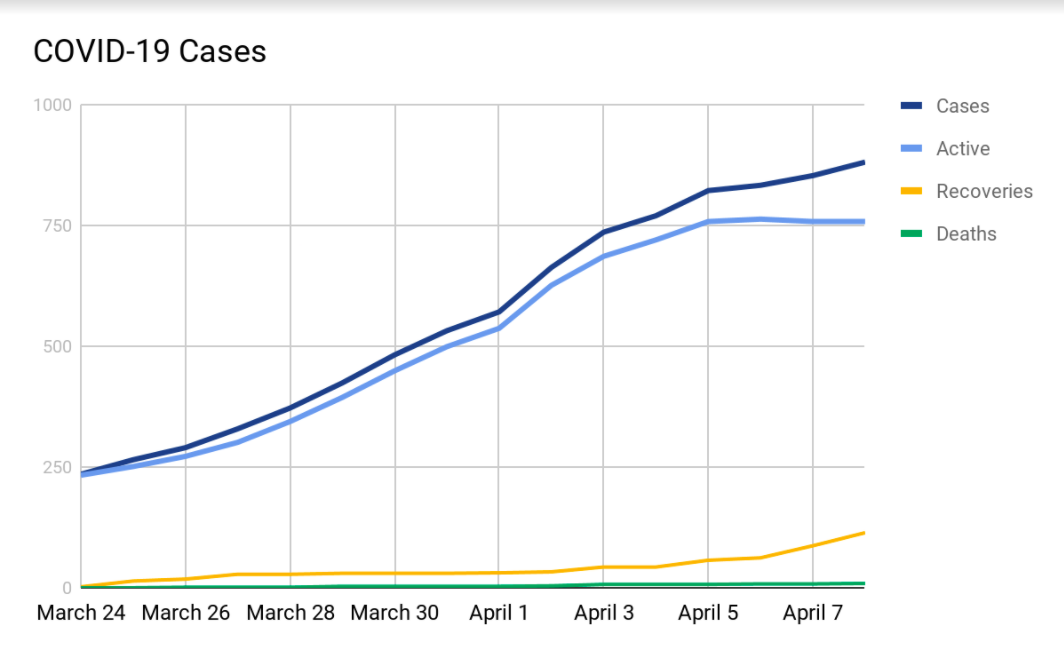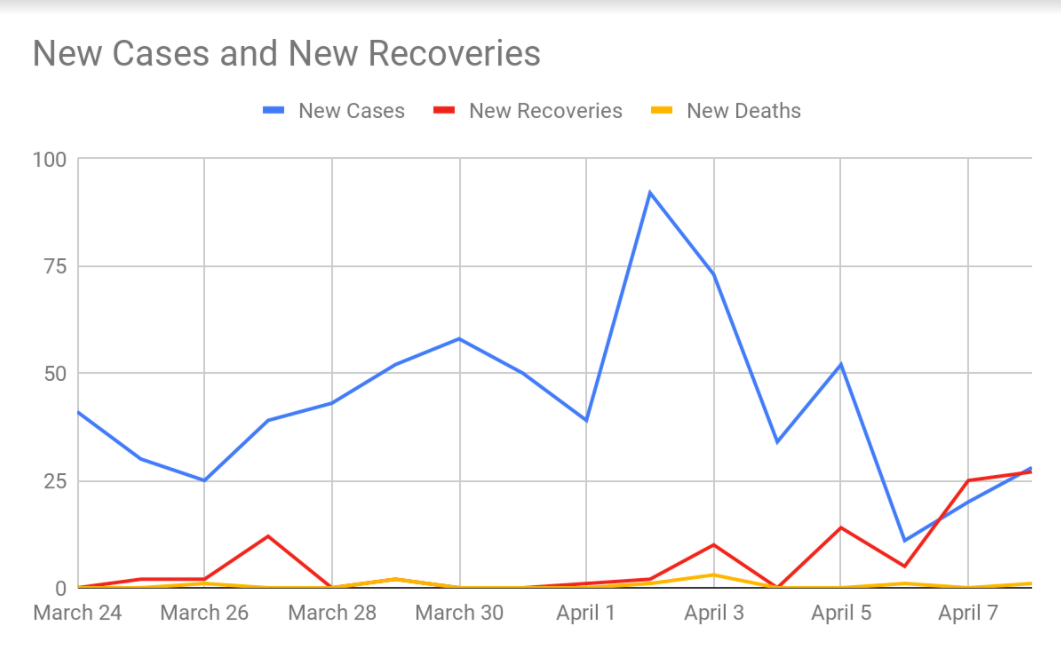
YEREVAN—Armenian Prime Minister Nikol Pashinyan expressed cautious optimism in his nightly Facebook Live broadcast on Tuesday that the rate of new COVID-19 infections in the country was steadily declining. Less than a week after Armenia registered its single largest daily jump in confirmed cases (92), the Centers for Disease Control (CDC) announced only 11 new infections on Palm Sunday.
While the following day saw a slightly higher figure of 20 new cases, it also marked the first time that recoveries outpaced new cases in a single day since the crisis began over a month ago. The noted slowing of the infection rate comes exactly two weeks after the Prime Minister ordered the first round of drastic lockdown measures, which included the closing of all restaurants and “non-essential business” on March 24. These measures have since been further enforced and extended on April 1 as cases continued to rise.

Due to the novel coronavirus’ unusually long incubation period, symptoms are often not detected until 10 to 14 days after infection. To complicate matters even further, many hosts often don’t express any symptoms at all, adding to the virality of the disease. As a result, public health officials across countries which have instituted lockdowns have warned citizens to expect a two-week delay between confirmed case figures and the actual infection rate to see results. Current data for Armenia appears to suggest that the effects of last month’s lockdown measures are starting to take hold.

The Prime Minister echoed, however, Health Minister Arsen Torosyan’s call for caution over this week’s optimistic figures. “[The data] should inspire all of us to remain maximally disciplined and comply with restrictions for one more week,” Pashinyan told viewers, after which he promised that the government will consider easing emergency measures in phases.
The public health service has been taking advantage of the respite by shoring up contingency measures to deal with expected new cases. The Health Ministry has already retrofitted a total of 16 medical centers and clinics across the country as designated COVID-19 treatment hubs, including eight hospitals in Yerevan. Other medical personnel have also undergone retraining in anti-contagion treatments, while some retired doctors have even volunteered their services in the event of a manpower shortage.
In one highly publicized feat, the Nork Infectious Diseases Center managed to build a new modular annex containing 43 wards in less than 10 days. Newly arrived COVID-19 testing kits are now making mass detection possible. Public health officials are confident that they can begin testing at a rate of 10,000 people per week—a critical tool in the ongoing struggle to contain and map the virus. Armenia already leads the region in terms of mass testing, with more than twice as many tests conducted as neighboring Georgia, which has at least 208 confirmed cases. In order to reduce reliance on foreign testing kits, bio labs across Armenia have begun producing an indigenous version of the test as well, thanks to a $500-thousand grant from the government.
.@MinHealth_Arm takes steps to be ready for every possible #COVID19🦠 development. Only few days, yet tremendous efforts to realize such projects🏥 to help & cure potential infected patients.👇@AToros_Official #TogetherAgainstCorona pic.twitter.com/ryi4AJF95z
— Armenian Unified Infocenter #StayHomeSaveLives (@ArmenianUnified) April 2, 2020
In addition to testing kits, much of Armenia’s industrial and manufacturing capacity is currently being retooled to produce surgical masks, Personal Protective Equipment (PPE), medical scrubs and other critical components. One engineering firm even unearthed Soviet-era blueprints for ventilators which they plan on improving before putting them into production.
The government has even launched an Android and iOS app which allows users to stay up to date with official communications pertaining to COVID-19, self-diagnose symptoms and contact healthcare workers if infection is suspected. The app is expected to supplement a mobile phone tracking scheme noting the movements of confirmed COVID-19 carriers in mapping the virus spread. The latter was a controversial decision made by the National Assembly last week after being significantly watered-down with the inclusion of guarantees that collected data would remain anonymous and scrubbed once the State of Emergency is lifted.
The total lockdown, which is now entering its third week, is expected to significantly impact the economy, which had hitherto been experiencing a period of robust growth. The issue is being further compounded by the ongoing outbreak in Russia (Armenia’s largest trade partner) and disruptions to the inbound tourism industry. The Ministry of Economy downgraded the country’s projected seven-percent GDP growth rate for 2020 to just under one percent. However, Economy Minister Tigran Khachatryan expects a rapid rebound, announcing in a press conference, “Despite the difficulties of 2020, we will quickly restore our economic activity and potential.” The Central Bank is equally optimistic in the longer term, setting growth projections for 2021 at just over seven percent.
The European Union (EU) is also providing Armenia, as well as other members of the Eastern Partnership, with material, technical and financial assistance to help weather the socio-economic effects of the anti-pandemic measures. The EU’s 51 million euro ($55 million) aid package includes at least 18 million euros in additional funds to purchase medical equipment, retrain healthcare professionals and boost the governments’ social spending for vulnerable members of society throughout the crisis.
Additionally, the EU is supporting the Labor and Social Affairs Ministry’s emergency social assistance programs. Labor and Social Affairs Minister Zaruhi Batoyan recently announced a fresh aid package for families of unregistered workers who were previously not eligible for unemployment insurance. The Minister had previously launched a series of grants and subsidized loans for local businesses, and made funds available for the newly unemployed, expectant mothers and pensioners to help cushion the economic impact.
While Russia provided assistance to Armenia in the form of a coronavirus testing lab and a sample collection system for COVID-19 tests, the two countries are also trying to settle a fresh dispute over the price of gas. Armenia imports 80 percent of its natural gas supplies from Russia, which has a history of using pricing for political leverage. Russian state-owned energy giant Gazprom has been insisting on raising the rate at which it sells gas to the Armenian network, despite the global price of gas having tanked over a recent spat between Moscow and Riyadh. Armenia has suggested, on numerous occasions, that payments be made in Russian rubles rather than US dollars.
In a show of international support this week, however, the Russian government allowed two commercial flights to transport at least 400 Armenian citizens back home; many were stranded in Moscow after the government installed a ban on commercial travel on April 3. Returning travelers will be in quarantine for two weeks.
As of Wednesday and the time of this writing, 881 cases of COVID-19 have been confirmed in Armenia and Artsakh, 785 of which are still active. Officials report that they have successfully identified the transmission point for “the vast majority” of these cases. Nine patients, all of whom were senior citizens with pre-existing chronic health conditions, have succumbed to the virus since the first case was reported on March 1st, while 90 percent of cases are either entirely asymptomatic or show very few signs. In total, 114 patients have successfully recovered according to the Armenian Unified Infocenter; hundreds more who had been under precautionary quarantine were sent home when test results turned out negative.


It’s good to see that the lockdown measures are working.
Meanwhile in ‘Murica, the ignoramus-in-chief thinks that the lockdown can end by Easter.